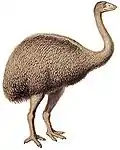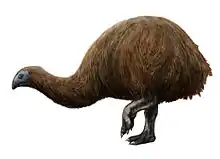| Palaeophasianus Temporal range: | |
|---|---|
| Scientific classification | |
| Domain: | Eukaryota |
| Kingdom: | Animalia |
| Phylum: | Chordata |
| Class: | Aves |
| Infraclass: | Palaeognathae |
| Family: | †Geranoididae |
| Genus: | †Palaeophasianus Shufeldt, 1913 |
| Species: | †P. meleagroides |
| Binomial name | |
| †Palaeophasianus meleagroides Shufeldt, 1913 | |
| Synonyms | |
| |
Palaeophasianus is an extinct genus of flightless Geranoididae birds that lived in North America during the Eocene period. Robert Wilson Shufeldt classified Palaeophasianus as a galliform when he described it in 1913.[1] However it was transferred to Cracidae in 1964 by Pierce Brodkorb,[2] while Joel Cracraft in 1968 placed it in Gruiformes.[3][4]
The only species in this genus is P. meleagroides,[5][6] and it is described as a "ground-dwelling carnivore".[6] The fossil remains were found by the American Museum expedition of 1910 in Big Horn County, Wyoming, in the Willwood formation (early Eocene).[7]
References
- ↑ Shufeldt, R.W. (1913). "Further studies of fossil birds with descriptions of new and extinct species". Bulletin of the American Museum of Natural History. 32: 285–306. hdl:2246/1412.
- ↑ Brodkorb, P. (1964). "Catalogue of fossil birds Part 2 (Anseriformes through Galliformes)". Bulletin of the Florida State Museum. 8: 195–335.
- ↑ Cracraft, Joel (August 1969). "Systematics and Evolution of the Gruiformes (Class, Aves)" (PDF). American Museum Novitates (2388). hdl:2246/2598.
- ↑ Cracraft, Joel (1968). "Reallocation of the Eocene Fossil Palaeophasianus meleagroides Shufeldt". The Wilson Bulletin. 80 (3): 281–285. ISSN 0043-5643. JSTOR 4159740.
- ↑ "Palaeophasianus". Fossilworks. Retrieved 2019-11-06 from the Paleobiology Database.
{{cite web}}: CS1 maint: postscript (link) - 1 2 "Palaeophasianus meleagroides". Fossilworks. Retrieved 2019-11-06 from the Paleobiology Database.
{{cite web}}: CS1 maint: postscript (link) - ↑ "Fossilworks: East of Dry Camp 2 (AMNH)". fossilworks.org. Retrieved 17 December 2021.
This article is issued from Wikipedia. The text is licensed under Creative Commons - Attribution - Sharealike. Additional terms may apply for the media files.
_white_background.jpg.webp)

